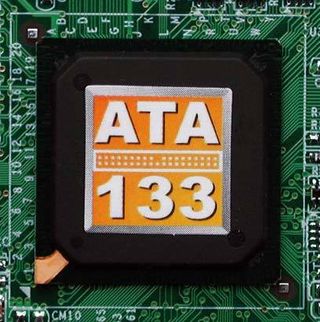VIA KT333 Put To The Test: 18 Motherboards Compared
Fastfame 6VQK: Latecomer
This board from newcomer Fastfame arrived at our labs after we had completed the tests, so we'll only talk about it in terms of functionality. Also, this is only a sample product, which you can easily tell by the numerous instances of corrective soldering. A noteworthy feature is the integrated network functionality (Realtek 8100B). No other board in this test is equipped with components as old as this: the Southbridge VIA VT8233 does without Ultra DMA/133. There's no USB 2.0 support either. Oddly enough, the manufacturer equips the memory clock chip with a heatsink. Also, the USB ports can only be used via a special cable. The large number of SMD components leads us to suspect that Fastfame hasn't really found a final layout yet. So there's hope for a more up-to-date product in the future.
Ultra-DMA/133: Currently Supported Only By Maxtor

Various modes can be set on boards with the KT333 chipset - even RAID is possible, if an additional controller is installed.
The new Southbridge VT8233A (distinguishable by the "A") has, among others, an Ultra DMA/133 IDE controller integrated. This means that a maximum data transfer rate of 133 MB/s is technically possible, minus a data overhead of about 10%. The latest 7200 rpm hard drives just barely achieve a data rate of about 50 MB/s, so with ATA/133, there are sufficient reserves to keep up-to-date for the next two years. However, there is a limitation: modern hard drives are equipped with a data cache of up to 8 MB, so the physical limit of 133 MB/s is quickly reached. From this, we can determine that Ultra DMA/133 hard disks make sense only starting from a specific minimum size for the internal cache (approx. 4 MB), as well as high read and write speeds with an ATA/133 interface. In the context of traditional CD ROMs, DVD drives and CD-RW drives, the Ultra-DMA/133 interface is superfluous. After all, the fastest 16x DVD drives have a maximum data throughput of 15 MB/s. Important note: compared to Ultra-DMA/100, both the interfaces and the cable connections remain identical.
Stay on the Cutting Edge
Join the experts who read Tom's Hardware for the inside track on enthusiast PC tech news — and have for over 25 years. We'll send breaking news and in-depth reviews of CPUs, GPUs, AI, maker hardware and more straight to your inbox.
Current page: Fastfame 6VQK: Latecomer
Prev Page Lucky Star K7VA333: Not Quite Mature Next Page Test Setup And DetailsMost Popular

